
The lily border is a great delight from mid-January on when the enormous blooms put on an entirely OTT display and the scent hangs heavy in the air. I planted it four years ago and looked at it this summer, thinking it needed a bit of attention. There were two or three areas which looked a bit sparse and others with a multitude of smaller bulbs starting to compete in the crowd. I shall lift and divide, I thought. I knew it would be a big job and thought maybe a solid week or ten days would do it.

More fool me. The lily border is about 30 metres long and up to 2 metres wide. A few days in and I worked out I could achieve about 1.5 lineal metres a day. I had a lot of time to do the maths, you understand, and the time stretched out on account of my two trips to Tauranga and a week off with cataract surgery. It became a very boring exercise and it was through gritted teeth that I persevered until I reached the end this week.
What was moderately interesting was analysing the bulbs I lifted. I planted them all as single bulbs at about 20 centimetre spacings coming up to four years ago. That meant a lot of bulbs. Say 50 square metres all up at 25 bulbs per square metre – up to 1250 bulbs. Even if it is only 40 square metres of actual area in bulbs, that is a 1000. I didn’t buy them. Mark did some controlled crosses, picking good parents, raised the seed and put them in his vegetable patch for future use.

Some bulbs had not increased much and were just setting babies on their stems. Some had clearly grown from seed in the first year or two before I started deadheading the border to reduce seeding. Others were large bulbs with two flowering stems last summer and clearly ready to be split apart.

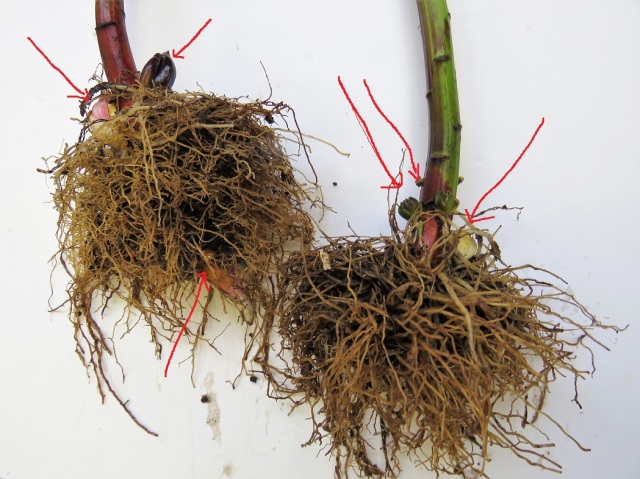
Others had become clusters of bulbs sticking together like a soccer ball, yielding 12 to 15 bulbs from medium small through to large. They were remarkably impressive for just four years. Mark tells me this is the end result of those bulbs that set lots of babies down their stem, usually just below the level of the soil down to where the flower stem emerges from the bulb.
I split all the multiplying bulbs apart, replanting just the flowering sized ones into the freshly dug bed, each covered with a generous scoop of compost before returning the soil and then the aged mulch that I had raked to one side before digging. I aimed to get the bulbs fairly deep – up to 20cm down because if they are planted deeply, they are better at holding themselves up without staking. There is no way I am going to be staking 1000 lily stems. We retain the spent seasonal foliage on site to replenish the soil so I stripped any remaining leaves and cut most of the stems into short lengths about 5cm long so that they will rot down quickly. We finished it off with a tidy top layer of wood chip.
The smallest bulbs were discarded. The smallish ones that will take another year or two to flower, I gave away until I could find no more takers. Zach planted the rest of the littlies back in Mark’s vegetable area for me. It is my emergency supply, I told him and he laughed. Having just planted five rows – fairly short rows, I admit – he felt I should have plenty for any contingency.

We were served Lilium brownii in China when we were there in 2016 but I had not realised until Mark asked me to do a net search that all true lilies are edible and L. auratum is a traditional food in both Japan and China. With so many auratum bulbs here, we tried one. I broke the bulb apart into its component scales, washed them thoroughly, tossed them in olive oil and roasted them. They are perfectly edible, texturally similar to chestnuts and with a flavour best described as inoffensive. They might be more exciting in a stir fry, preferably with added garlic but they are not sufficiently tasty for me to want to add them to our diet on a regular basis.
In fact, all parts of the lily are edible but I will not be harvesting the fresh shoots as an early summer green and eating the massive flowers seems a bit daunting. But should we get hit by famine, it is comforting to know that we have a generous additional food source here we can harvest at will.


 Auratum lily time is a delight, a joy even. Showy, over the top, flamboyant but glorious. And we are just entering these weeks of glory.
Auratum lily time is a delight, a joy even. Showy, over the top, flamboyant but glorious. And we are just entering these weeks of glory. We grow lilies in the better lit areas of woodland. They can get somewhat stretched reaching for the light so need more staking when not in full sun. I am rounding them up to limit the areas where we have them growing in order to make that seasonal staking task easier. But they certainly light up the woodland margins.
We grow lilies in the better lit areas of woodland. They can get somewhat stretched reaching for the light so need more staking when not in full sun. I am rounding them up to limit the areas where we have them growing in order to make that seasonal staking task easier. But they certainly light up the woodland margins. The new lily border has just opened its earliest flowers. These are the result of a determined and sustained effort to
The new lily border has just opened its earliest flowers. These are the result of a determined and sustained effort to 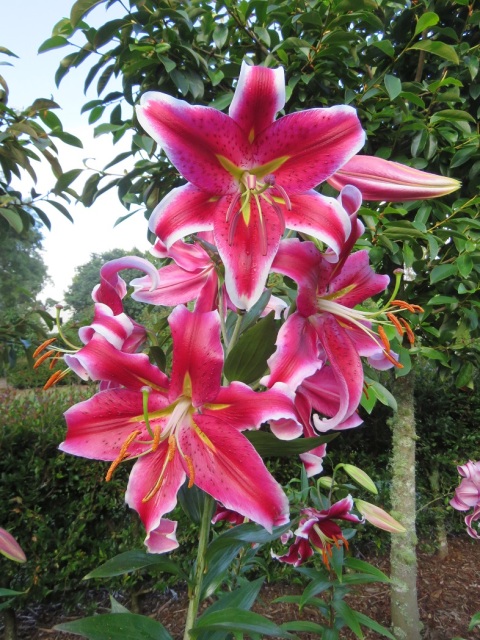 Almost all of ours are unnamed hybrids raised by father and son – first Felix and now Mark. Felix named a few that we used to sell but they are pretty mixed in the garden now. All are outward facing, not upward facing. That was one of the breeding aims. Upward facing lilies act as leaf and debris catchers and weather-mark badly.
Almost all of ours are unnamed hybrids raised by father and son – first Felix and now Mark. Felix named a few that we used to sell but they are pretty mixed in the garden now. All are outward facing, not upward facing. That was one of the breeding aims. Upward facing lilies act as leaf and debris catchers and weather-mark badly. Of them all, I think these soft, marshmallow pink ones of Mark’s raising may be my favourite. Or it could be another one in a few days’ time.
Of them all, I think these soft, marshmallow pink ones of Mark’s raising may be my favourite. Or it could be another one in a few days’ time. Finally, just in case there are any lily experts reading this: I assumed these trumpet lilies elsewhere in the garden are an unusual, honey-coloured
Finally, just in case there are any lily experts reading this: I assumed these trumpet lilies elsewhere in the garden are an unusual, honey-coloured 
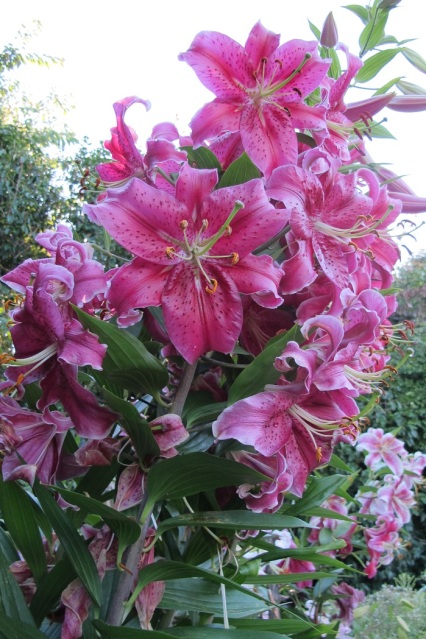 As 2018 draws to a close, I decided that I do not have anything to say on
As 2018 draws to a close, I decided that I do not have anything to say on  Firstly, January is for lilies.
Firstly, January is for lilies.  February is peak summer here, when we get the most settled and warmest weather. And the
February is peak summer here, when we get the most settled and warmest weather. And the 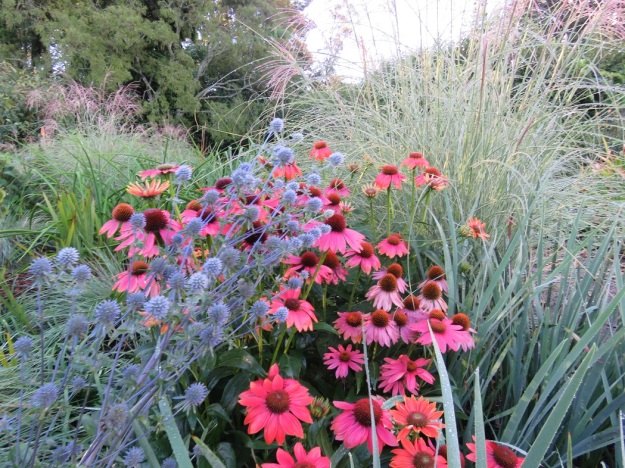 March is still summer here although the day length is shortening and the nights noticeably cooler. It used to be a very green time for us, because we have so much woodland garden and there is not a whole lot of high impact flowering in later summer woodland. We went to England three times to look at summer gardens and it is the sunny perennials that flower into this time. It has been really exciting putting in a large summer garden in full sun. I am extremely impressed by the echinaceas which flower from December to April and I have a very soft spot for the blue eryngium, even if I often need to put a stake in to hold them upright.
March is still summer here although the day length is shortening and the nights noticeably cooler. It used to be a very green time for us, because we have so much woodland garden and there is not a whole lot of high impact flowering in later summer woodland. We went to England three times to look at summer gardens and it is the sunny perennials that flower into this time. It has been really exciting putting in a large summer garden in full sun. I am extremely impressed by the echinaceas which flower from December to April and I have a very soft spot for the blue eryngium, even if I often need to put a stake in to hold them upright. By April, we can no longer pretend that summer will go on forever. The flowering of the
By April, we can no longer pretend that summer will go on forever. The flowering of the  May brings us the early camellias in bloom, in this case
May brings us the early camellias in bloom, in this case  June is early winter here. Definitely winter. I could have chosen Mark’s Daphne ‘Perfume Princess’ which flowers on and on through the winter months, but instead I picked Vireya Rhododendron macgregoriae. This particular plant has
June is early winter here. Definitely winter. I could have chosen Mark’s Daphne ‘Perfume Princess’ which flowers on and on through the winter months, but instead I picked Vireya Rhododendron macgregoriae. This particular plant has  July is our bleakest, coldest month. But there is light ahead. July brings us snowdrops and by the end of the month, we have the earliest blooms opening on both the deciduous magnolias and the early michelias. Nothing shouts spring more than the earliest spring blooms. Mark would like some galanthus varieties that flowered later in the season as well and he has tried all that are available, but none of them compete with Galanthus ‘S. Arnott’ for showy and reliable performance and the ability to naturalise in his bulb meadows that are a long-term project.
July is our bleakest, coldest month. But there is light ahead. July brings us snowdrops and by the end of the month, we have the earliest blooms opening on both the deciduous magnolias and the early michelias. Nothing shouts spring more than the earliest spring blooms. Mark would like some galanthus varieties that flowered later in the season as well and he has tried all that are available, but none of them compete with Galanthus ‘S. Arnott’ for showy and reliable performance and the ability to naturalise in his bulb meadows that are a long-term project.
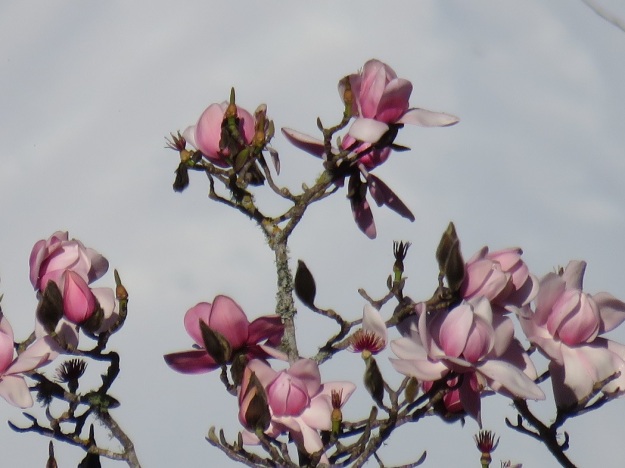 August – yes there is a lot of snow on our Mount Taranaki. All the better to frame our
August – yes there is a lot of snow on our Mount Taranaki. All the better to frame our  I gave September to the prunus, the flowering cherries. It is probably the campanulatas that are the showiest and they flower in August and I had already allocated that month to magnolias. But we grow quite a range of flowering cherries and this one is down in our wild North Garden, an area that we find particularly charming at this time of the year.
I gave September to the prunus, the flowering cherries. It is probably the campanulatas that are the showiest and they flower in August and I had already allocated that month to magnolias. But we grow quite a range of flowering cherries and this one is down in our wild North Garden, an area that we find particularly charming at this time of the year.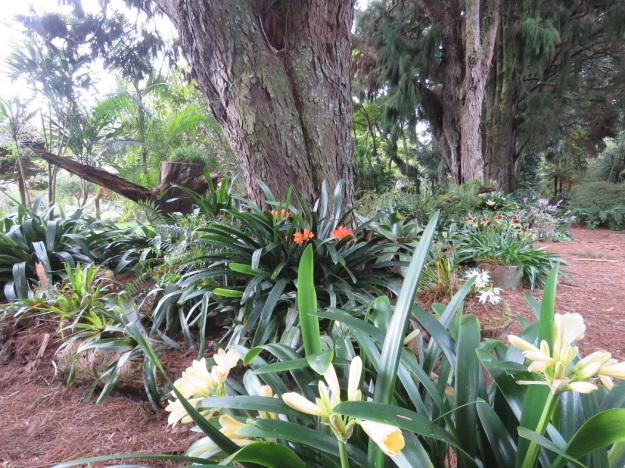 October is mid spring. And for October, I chose the clivias yellow, orange and red, seen here with Hippeastrum papilio and dendrobium orchids in the Rimu Avenue. As I selected photos, I realised I was leaning to what we might call our backbone flowering plants – the ones we have a-plenty. Not all of them. I had to skip the azaleas, the michelias, the campanulatas and the hydrangeas owing to my self-imposed restrictions of one per month.
October is mid spring. And for October, I chose the clivias yellow, orange and red, seen here with Hippeastrum papilio and dendrobium orchids in the Rimu Avenue. As I selected photos, I realised I was leaning to what we might call our backbone flowering plants – the ones we have a-plenty. Not all of them. I had to skip the azaleas, the michelias, the campanulatas and the hydrangeas owing to my self-imposed restrictions of one per month. November brings us peak nuttallii and maddenii rhododendrons. The rhododendrons start in August, sometimes the first blooms as early as July, and flower well into December. But the beautiful nuttallis and maddeniis peak in November and are a source of great delight.
November brings us peak nuttallii and maddenii rhododendrons. The rhododendrons start in August, sometimes the first blooms as early as July, and flower well into December. But the beautiful nuttallis and maddeniis peak in November and are a source of great delight. Finally, December is marked by the Higo iris down in the meadow in our park. What prettier way to end the calendar year? And gardening being what gardening is, we start the cycle again with a new year. Best wishes to all readers for a happy and rewarding 2019.
Finally, December is marked by the Higo iris down in the meadow in our park. What prettier way to end the calendar year? And gardening being what gardening is, we start the cycle again with a new year. Best wishes to all readers for a happy and rewarding 2019.



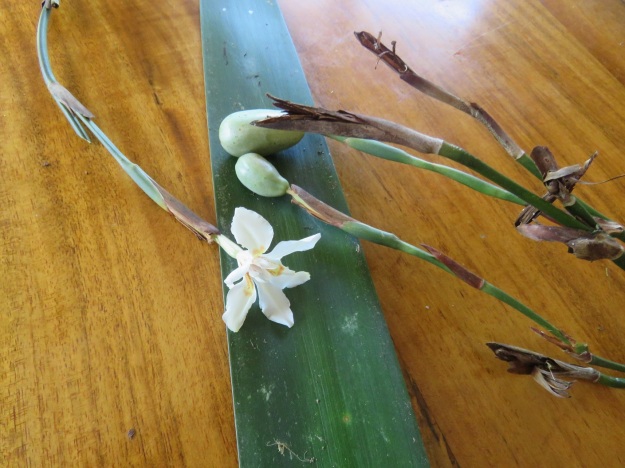

 It is
It is 
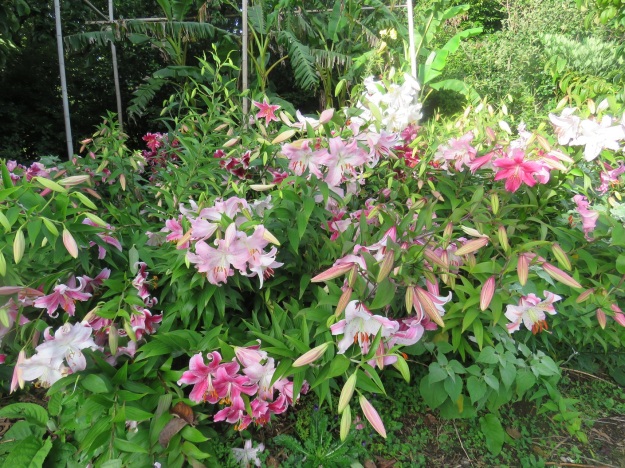


 In the garden it is still all about lilies. Big, blowsy, over the top auratum lilies. I am not picking the ones in the garden but in a small area of Mark’s new vegetable garden is a congested block of his seedling auratums, raised in anticipation of our new summer garden. There I can pick by the armful and oh, how I love these extravagant blooms. Auratums are a strong argument for the vigilant border control we have in this country. We do not, repeat NOT, need the lily beetle here. It is a nasty critter that takes up residence on auratum lilies and covers itself in its own excrement. We have seen it in the UK where it is an unwelcome arrival which has all but destroyed the auratum display in some areas.
In the garden it is still all about lilies. Big, blowsy, over the top auratum lilies. I am not picking the ones in the garden but in a small area of Mark’s new vegetable garden is a congested block of his seedling auratums, raised in anticipation of our new summer garden. There I can pick by the armful and oh, how I love these extravagant blooms. Auratums are a strong argument for the vigilant border control we have in this country. We do not, repeat NOT, need the lily beetle here. It is a nasty critter that takes up residence on auratum lilies and covers itself in its own excrement. We have seen it in the UK where it is an unwelcome arrival which has all but destroyed the auratum display in some areas.

 Following my final photo feature for the Waikato Times on the topic of
Following my final photo feature for the Waikato Times on the topic of 